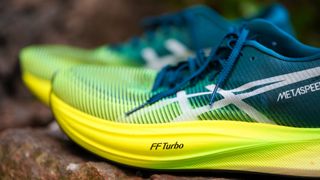ActiveRunningI ran a 10k every day for a week – 6 things I learned from the experienceRunning a 10k every day for 7 days taught me a lot about recovery and resilienceWhen you purchase through links on our site, we may earn an affiliate commission.Here’s how it works.
ActiveRunningI ran a 10k every day for a week – 6 things I learned from the experienceRunning a 10k every day for 7 days taught me a lot about recovery and resilienceWhen you purchase through links on our site, we may earn an affiliate commission.Here’s how it works.
Running a 10k every day for 7 days taught me a lot about recovery and resilience
When you purchase through links on our site, we may earn an affiliate commission.Here’s how it works.
(Image credit: Matt Kollat/T3)

(Image credit: Matt Kollat/T3)
After a few months of putting more emphasis on strength training, I decided to start running more again, not least because the weather was nice and I had loads of shoes to test. I thought, a 10k a day for a week should be challenging enough to get my legs ready for more strenuous training but without absolutely killing myself in the process. Was it a good idea? Well, yes and no.
I love running. It’s a form of movement I always found comfort in, no matter the mileage. Some weeks, I’ll be running more, while on others, I’ll be focusing on strength training or HIIT or walking. Either way, running has always been part of my life to some degree.
I’m not a fast runner; I never made the ultimate sacrifice of shedding all the extra muscle mass in order to reach maximum running speed. That said, I’m not a slow runner either – I can run a half marathon in under 90 minutes, for what it’s worth, although I know many amateur runners can do it under 70.
After building a semi-decent home gym during the pandemic/lockdown (I even have abarbelland 100 kg ofbumper plates,much to the delight of my neighbours), I shifted my efforts towards strength training and home workouts, away from running. I jogged occasionally and tested thebest running shoes, of course, but I wasn’t out running multiple times a day as I sometimes do when I train for races etc.
Running 10k every day for a week: Play it safe
However, in the last four weeks, I met some very inspirational runners who reignited my passion for running; not to mention, I also had loads of running shoes to test so decided it was time to return to running as my main recreational activity. I had to up the mileage so I decided to run 10k every day for a week – that should do it, for now.
Upping my mileage so much did come with some caveats. Most importantly, I realised (yet again) that there is a reason why the 10% rule exists. As a general rule of thumb, you should only increase your weekly mileage in increments of 10 per cent to preserve leg health and avoid injury.
If you run 10 miles a week and would like to run more, you should run 11 miles the second week, 12.1 miles the week after and so on.
Sign up to the T3 newsletter for smarter living straight to your inbox
Get all the latest news, reviews, deals and buying guides on gorgeous tech, home and active products from the T3 experts
I completely ignored this rule and instead, went straight for the kill with this challenge. And indeed, my legs were a bit tender – to say the least – halfway through the challenge. As well as learning to appreciate the 10% rule, I also learned six more things from running a 10k every day for a week, as detailed below.
For the record, here ismy Stravaas proof that I actually ran 10k every day and not just saying it like some other publications often do…
This is how it looks like when I’m doing pull-ups, 100 times a day(Image credit: Future)
This is how it looks like when I’m doing pull-ups, 100 times a day
This is how it looks like when I’m doing pull-ups, 100 times a day
(Image credit: Future)
1. Fitness challenges are st*pid
I seldom do fitness challenges and when I do, it’s because I got myself into a training rut. I did100 pull-ups for a weekbefore and even attempted the10,000-swing kettlebell challenge. However, every time I do these challenges, I keep thinking I don’t want to do them anymore as they are just silly.
The main problem with fitness challenges is that they usually overload one area of the body (often one muscle group) and neglect others entirely. This is not healthy or beneficial for your physical development. If anything, it’s dangerous and pointless – yet, people can’t stop reading about fitness challenges, so people keep on doing them.
2. Recovery is everything
The “make sure my body was ready” part in the above sentence refers to recovery, the most important part of this challenge, at least as far as I was concerned. Even before I started, I knew my legs won’t like the training load increase, so I followed a rigorous recovery schedule from day 1 to ensure I minimise the risk of injury as much as possible.
This involved warm-ups – sometimes, I used amassage gunto energise my calves pre-run – post-runfoam rollersessions and the use of my favourite recovery tool, theTherabody RecoveryAir JetBoots. I also made sure I slept as well as possible and even worecompression socks for runningafter the runs to enhance recovery.
The only I didn’t do was ice baths,something I really likebut haven’t got the capacity at home to do. If I had a barrel or something that could keep its cool without me wasting tons of water every day, I would totally use them for post-run recovery. But even without the ice barrel, I used every tool I had at my disposal to avoid injury.
Running a lot can be a painful experience(Image credit: Getty)

Running a lot can be a painful experience
Running a lot can be a painful experience
(Image credit: Getty)
3. Lungs are fine, heart is fine, stamina is fine, legs are… not fine
On my daily runs, I always checked in with my body to see how it was doing. I started with the lungs, then the heart and I even checked my stamina which is super easy if you have aGarmin Fenix 7XorGarmin Epix (Gen 2)multisport watch(I have the former).
All three of these metrics were fine; if anything, they kept improving as the week went on.
One area that didn’t improve and, in fact, got worse, was my legs, especially the calves and the shins. It got to the point on day 3 where any change in incline felt like someone was stabbing my lower legs with a knife, so I ended up running the same small 1.1k loop nine times over – that was the only area where the elevation didn’t bother me.
4. It’s all in the head
Leg pain aside, I often found myself wanting to stop after 5-6-7k just for the sake of it. My brain kept telling me I had run enough; it was time to slow down and allow my legs to recuperate. More often than not, I could force myself to keep going, even if it was a bit slower, which goes to show that being able to run for longer distances is only partially down to physical preparedness – you also have to be ready in your head.
I like running without music – as much as I loverunning headphones– but this means that sometimes I can get caught up in my thoughts as nothing takes away my attention from how tired I am or how achy my legs are. I can easily convince myself that my legs are too tired to go on or that I need just a little break to help me power through the rest of the workout.
Try not to cave in and always keep the main goal of the workout in mind – that could help you push through, no matter how impenetrablethe wallfeels.
(Image credit: Matt Kollat/T3)

(Image credit: Matt Kollat/T3)
5. You must have the right running gear if you do high-mileage training
I’m lucky enough to have access to the best running gear; after all, I test running shoes for a living. For this challenge, I chose to run in different shoes every day to see what difference they made (if any). Here is the list of shoes I wore:
As you can see, I tried to mix things up a bit; I wore daily trainers as well as racing andtrail running shoes. I even sneaked in a pair ofstability running shoesright at the end, just for good measure.
I also wore differentrunning shortsandrunning tops; my favourites wereBrooks' Sherpa 3" Split Shorts(retailer link) andNew Balance’s London Edition Impact Run Singlet(also a retailer link). From arunning sockspoint of view, nothing beats theAdidas UltraLight Performance Crew Running Socksin Pink (you guessed it, retailer link); it’s light and looks sexy.
6. Variety is key in training
One of the most important things I learned from my experience is just how important variety is when it comes to training. Doing the same workout day after day is not only dull, but it’s also dangerous as it forces the same muscles and joints to do the same movement over and over again with the same intensity. This type of training gets repetitive and doesn’t allow for recovery; again, the best way to get injured.
The more intense your training, the more varied it should be. There are manydifferent types of running training, from fartlek to recovery runs, and you should use them all toget better at runningand keep things fresh. Even if your plan is as straightforward asrunning a faster 5k, introducing sprint sessions and longer, slow-paced runs can help you move forward in your training plan.
Somerunning watches– especially thebest Garmin watches– have built-in running coaches that can train you in a sensible way, even if you’re afraid of asking a human coach for help.

My most anticipated Apple TV+ show gets another tantalising teaserThe Studio gets a minute tease
The Studio gets a minute tease

Build bigger arms in just 30 minutes with this 5-move dumbbell-only workoutIt’ll leave the biceps and triceps popping!
It’ll leave the biceps and triceps popping!